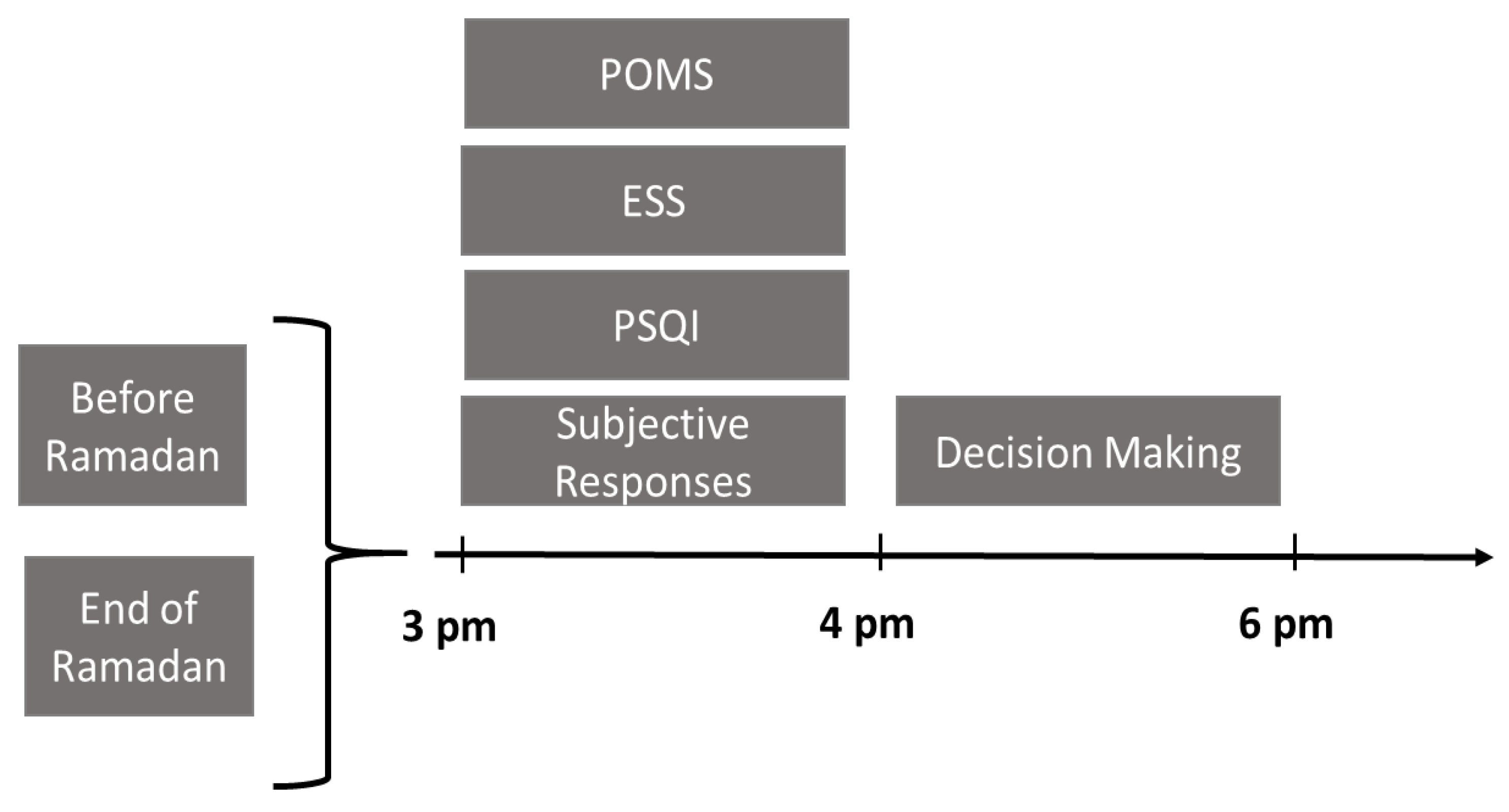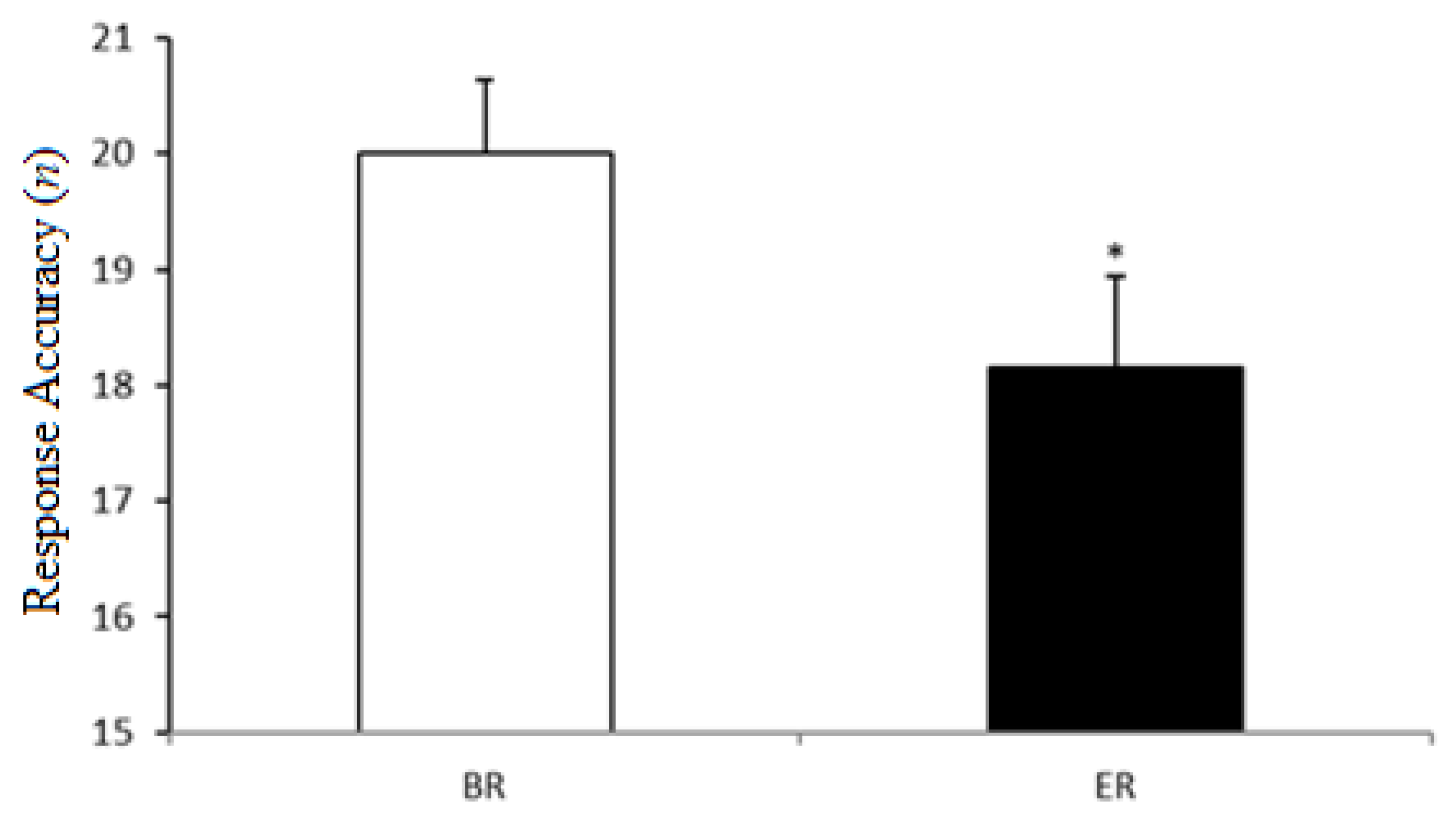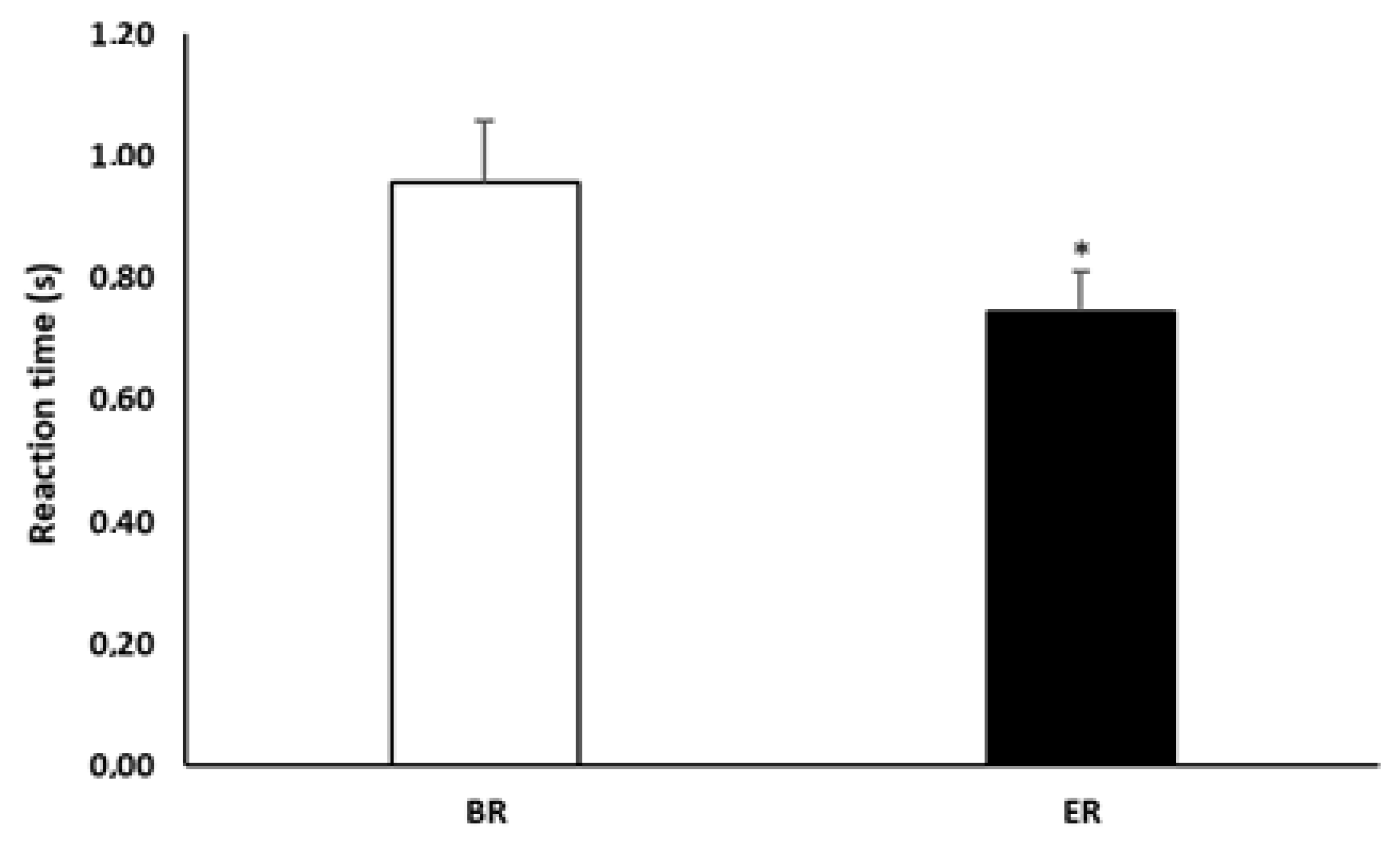Ramadan Observance Is Associated with Impaired Kung-Fu-Specific Decision-Making Skills
Abstract
:1. Introduction
2. Materials and Methods
2.1. Participants
2.2. Material and Apparatus
2.3. Experimental Design
2.4. Procedure
2.5. The Profile of Mood States (POMS)
2.6. The Epworth Sleepiness Scale (ESS)
2.7. The Pittsburg Sleep Quality Index (PSQI)
2.8. Perceptual Measures
2.9. Statistical Analysis
3. Results
3.1. Profile of Mood States (POMS)
3.2. Epworth Sleepiness Scale (ESS)
3.3. The Pittsburgh Sleep Quality Index (PSQI)
3.4. Perceptual Measures
3.5. Decision-Making: Response Accuracy and Reaction Time
4. Discussion
5. Conclusions
Author Contributions
Funding
Institutional Review Board Statement
Informed Consent Statement
Data Availability Statement
Conflicts of Interest
References
- Chtourou, H. Effects of Ramadan Fasting on Health and Athletic Performance; Omics Group International: New York, NY, USA, 2015; pp. 6–14. Available online: https://www.esciencecentral.org/ebooks/ebookdetail/effects-of-ramadan-fasting-on-healthand-athletic-performance (accessed on 7 July 2014). [CrossRef] [Green Version]
- Chtourou, H.; Trabelsi, K.; Boukhris, O.; Ammar, A.; Shephard, R.J.; Bragazzi, N.L. Effects of Ramadan fasting on physical performances in soccer players: A systematic review. Tun. Med. 2019, 97, 1114–1131. [Google Scholar]
- Abaïdia, A.E.; Daab, W.; Bouzid, M.A. Effects of Ramadan fasting on physical performance: A systematic review with meta-analysis. Sports Med. 2020, 50, 1009–1026. [Google Scholar] [CrossRef] [PubMed]
- Aloui, A.; Baklouti, H.; Souissi, N.; Chtourou, H. Effects of Ramadan fasting on body composition in athletes: A systematic review Effets du jeûne du Ramadan sur la composition corporelle des sportifs: Revue systématique. Tun. Med. 2019, 97, 1087–1094. [Google Scholar]
- Chtourou, H.; Chtourou, L.; Trabelsi, K.; Tahri, N.; Souissi, N. Possible gastrointestinal disorders for athletes during Ramadan: An overview. Biol. Rhythm Res. 2018, 49, 51–60. [Google Scholar] [CrossRef]
- Boukhris, O.; Hsouna, H.; Chtourou, L.; Abdesalem, R.; BenSalem, S.; Tahri, N.; Trabelsi, K.; Stannard, S.R.; Chtourou, H. Effect of Ramadan fasting on feelings, dietary intake, rating of perceived exertion and repeated high intensity short-term maximal performance. Chronobiol. Int. 2019, 36, 1–10. [Google Scholar] [CrossRef]
- Trabelsi, K.; Ammar, A.; Zlitni, S.; Boukhris, O.; Khacharem, A.; El-Abed, K.; Khanfir, S.; Shephard, R.J.; Stannard, S.R.; Bragazzi, N.L.; et al. Practical recommendations to improve sleep during Ramadan observance in healthy practitioners of physical activity. Tun. Med. 2019, 97, 1077–1086. [Google Scholar]
- Trabelsi, K.; Bragazzi, N.; Zlitni, S.; Khacharem, A.; Boukhris, O.; El-Abed, K.; Ammar, A.; Khanfir, S.; Shephard, R.J.; Hakim, A.; et al. Observing Ramadan and sleep-wake patterns in athletes: A systematic review, meta-analysis and meta-regression. Br. J. Sports Med. 2019, 54, 674–680. [Google Scholar] [CrossRef]
- Chamari, K.; Briki, W.; Farooq, A.; Patrick, T.; Belfekih, T.; Herrera, C.P. Impact of Ramadan intermittent fasting on cognitive function in trained cyclists: A pilot study. Biol. Sport 2016, 33, 49. [Google Scholar] [CrossRef] [PubMed]
- Chennaoui, M.; Desgorces, F.; Drogou, C.; Boudjemaa, B.; Tomaszewski, A.; Depiesse, F.; Burnat, P.; Chalabi, H.; Gomez-Merino, D. Effects of Ramadan fasting on physical performance and metabolic, hormonal, and inflammatory parameters in middle-distance runners. Appl. Physiol. Nutr. Metab. 2009, 34, 587–594. [Google Scholar] [CrossRef]
- Chtourou, H.; Hammouda, O.; Souissi, H.; Chamari, K.; Chaouachi, A.; Souissi, N. The effect of Ramadan fasting on physical performances, mood state and perceived exertion in young footballers. Asian J. Sports Med. 2011, 2, 177. [Google Scholar] [CrossRef] [PubMed] [Green Version]
- Chtourou, H.; Hammouda, O.; Chaouachi, A.; Chamari, K.; Souissi, N. The effect of time-of-day and Ramadan fasting on anaerobic performances. Int. J. Sports Med. 2012, 33, 142–147. [Google Scholar] [CrossRef] [PubMed]
- Baklouti, H.; Rejeb, N.; Aloui, A.; Jaafar, H.; Ammar, A.; Chtourou, H.; Girard, O.; Souissi, N. Short versus long small-sided game training during Ramadan in soccer players. Phys. Ther. Sport 2017, 24, 20–25. [Google Scholar] [CrossRef] [PubMed]
- Boukhris, O.; Trabelsi, K.; Shephard, R.J.; Hsouna, H.; Abdessalem, R.; Chtourou, L.; Ammar, A.; Braggazi, N.L.; Chtourou, H. Sleep patterns, alertness, dietary intake, muscle soreness, fatigue, and mental stress recorded before, during and after Ramadan observance. Sports 2019, 7, 118. [Google Scholar] [CrossRef] [Green Version]
- Chaouachi, A.; Coutts, A.J.; Chamari, K.; Wong, D.P.; Chaouachi, M.; Chtara, M.; Roky, R.; Amri, M. Effect of Ramadan intermittent fasting on aerobic and anaerobic performance and perception of fatigue in male elite judo athletes. J. Strength Cond. Res. 2009, 23, 2702–2709. [Google Scholar] [CrossRef] [Green Version]
- Dye, L.; Lluch, A.; Blundell, J.E. Macronutrients and mental performance. Nutrition 2000, 16, 1021–1034. [Google Scholar] [CrossRef]
- Gibson, E.L.; Green, M.W. Nutritional influences on cognitive function: Mechanisms of susceptibility. Nutr. Res. Rev. 2002, 15, 169–206. [Google Scholar] [CrossRef]
- McCartney, D.; Desbrow, B.; Irwin, C. The effect of fluid intake following dehydration on subsequent athletic and cognitive performance: A systematic review and meta-analysis. Sports Med. Open 2017, 3, 13. [Google Scholar] [CrossRef] [Green Version]
- Fortes, L.S.; Nascimento-Júnior, J.R.; Mortatti, A.L.; Lima-Júnior, D.R.A.A.D.; Ferreira, M.E. Effect of dehydration on passing decision making in soccer athletes. Res. Q. Exerc. Sport 2018, 89, 332–339. [Google Scholar] [CrossRef]
- Taheri, M.; Arabameri, E. The effect of sleep deprivation on choice reaction time and anaerobic power of college student athletes. Asian J. Sports Med. 2012, 3, 15. [Google Scholar] [CrossRef] [PubMed] [Green Version]
- Fullagar, H.H.; Skorski, S.; Duffield, R.; Hammes, D.; Coutts, A.J.; Meyer, T. Sleep and athletic performance: The effects of sleep loss on exercise performance, and physiological and cognitive responses to exercise. Sports Med. 2015, 45, 161–186. [Google Scholar] [CrossRef]
- Tian, H.H.; Aziz, A.R.; Png, W.; Wahid, M.F.; Yeo, D.; Png, A.L.C. Effects of fasting during Ramadan month on cognitive function in Muslim athletes. Asian J. Sports Med. 2011, 2, 145. [Google Scholar] [CrossRef] [Green Version]
- Ottoboni, G.; Russo, G.; Tessari, A. What boxing-related stimuli reveal about response behaviour. J. Sports Sci. 2015, 33, 1019–1027. [Google Scholar] [CrossRef]
- Russo, G.; Ottoboni, G. The perceptual–Cognitive skills of combat sports athletes: A systematic review. Psychol. Sport Exerc. 2019, 44, 60–78. [Google Scholar] [CrossRef]
- Ahmed, A.E.; Fatani, A.; Al-Harbi, A.; Al-Shimemeri, A.; Ali, Y.Z.; Baharoon, S.; Al-Jahdali, H. Validation of the Arabic version of the Epworth sleepiness scale. J. Epidemiol. Glob. Health 2014, 4, 297–302. [Google Scholar] [CrossRef] [PubMed] [Green Version]
- Cayrou, S.; Dickès, P.; Dolbeault, S. Version française du profile of mood states (POMS-f). J. Ther. Comport. Cogn. 2003, 13, 83–88. [Google Scholar]
- Suleiman, K.H.; Yates, B.C.; Berger, A.M.; Pozehl, B.; Meza, J. Translating the Pittsburgh sleep quality index into Arabic. West. J. Nurs. Res. 2010, 32, 250–268. [Google Scholar] [CrossRef]
- Aziz, A.R.; Wahid, M.F.; Png, W.; Jesuvadian, C.V. Effects of Ramadan fasting on 60 min of endurance running performance in moderately trained men. Br. J. Sports Med. 2010, 44, 516–521. [Google Scholar] [CrossRef] [PubMed]
- Johns, M. The Assessment of ‘Sleepiness’ in Human Drug Trials: A New Perspective. Curr. Psychopharmacol. 2019, 8, 5–26. [Google Scholar] [CrossRef]
- Buysse, D.J.; Reynolds, C.F., III; Monk, T.H.; Berman, S.R.; Kupfer, D.J. The Pittsburgh Sleep Quality Index: A new instrument for psychiatric practice and research. Psychiatry Res. 1989, 28, 193–213. [Google Scholar] [CrossRef]
- Moghaddam, J.F.; Nakhaee, N.; Sheibani, V.; Garrusi, B.; Amirkafi, A. Reliability and validity of the Persian version of the Pittsburgh Sleep Quality Index (PSQI-P). Sleep Breath 2012, 16, 79–82. [Google Scholar] [CrossRef]
- Faul, F.; Erdfelder, E.; Lang, A.G.; Buchner, A. G* Power 3: A flexible statistical power analysis program for the social, behavioral, and biomedical sciences. Behav. Res. Methods 2007, 39, 175–191. [Google Scholar] [CrossRef] [PubMed]
- Beck, T.W. The importance of a priori sample size estimation in strength and conditioning research. J. Strength Cond. Res. 2013, 27, 2323–2337. [Google Scholar] [CrossRef]
- Cohn, J. Statistical Power Analysis for the Behavioral Sciences; Lawrence Earlbam Associate: Hills-dale, NJ, USA, 1988. [Google Scholar]
- Cherif, A.; Roelands, B.; Meeusen, R.; Chamari, K. Effects of intermittent fasting, caloric restriction, and Ramadan intermittent fasting on cognitive performance at rest and during exercise in adults. Sports Med. 2016, 46, 35–47. [Google Scholar] [CrossRef] [PubMed]
- Ali, M.R.; Amir, T. Effects of fasting on visual flicker fusion. Percept. Mot. Ski 1989, 69, 627–631. [Google Scholar] [CrossRef]
- Dolu, N.; Yiiksek, A.; Sizer, A.; Alay, M. Arousal and continuous attention during Ramadan intermittent fasting. J. Basic Clin. Physiol. Pharm. 2007, 18, 315–322. [Google Scholar] [CrossRef]
- El Moutawakil, B.; Hassounr, S.; Sibai, M.; Rafai, M.A.; Fabrigoule, C.; Slassi, I. N-10 Impact du jeûn du Ramadan sur les fonctions attentionnelles. Rev. Neurol. 2007, 163, 60. [Google Scholar] [CrossRef]
- Bouhlel, E.; Shephard, R.J. Optimizing Physical Performance During Fasting and Dietary Restriction: Implications for Athletes and Sports Medicine; CRC Press: Boca Raton, FL, USA, 2015. [Google Scholar]
- Lotfi, S.; Madani, M.; Abassi, A.; Tazi, A.; Boumahmaza, M.; Talbi, M. CNS activation, reaction time, blood pressure and heart rate variation during ramadan intermittent fasting and exercise. World J. Sport Sci. 2010, 3, 37–43. [Google Scholar]
- Bouhlel, H.; Latiri, I.; Zarrrouk, N.; Bigard, X.; Shephard, R.; Tabka, Z.; Bouhlel, E. Effect of Ramadan observance and maximal exercise on simple and choice reaction times in trained men. Sci. Sports 2014, 29, 131–137. [Google Scholar] [CrossRef]
- Venkatraman, V.; Chuah, Y.L.; Huettel, S.A.; Chee, M.W. Sleep deprivation elevates expectation of gains and attenuates response to losses following risky decisions. Sleep 2007, 30, 603–609. [Google Scholar] [CrossRef] [Green Version]
- Roky, R.; Houti, I.; Moussamih, S.; Qotbi, S.; Aadil, N. Physiological and chronobiological changes during Ramadan intermittent fasting. Ann. Nutr. Metab. 2004, 48, 296–303. [Google Scholar] [CrossRef]
- Zerguini, Y.; Kirkendall, D.; Junge, A.; Dvorak, J. Impact of Ramadan on physical performance in professional soccer players. Br. J. Sports Med. 2007, 41, 398–400. [Google Scholar] [CrossRef] [Green Version]
- Herrera, C.P. Total sleep time in Muslim football players is reduced during Ramadan: A pilot study on the standardized assessment of subjective sleep–wake patterns in athletes. J. Sports Sci. 2012, 30 (Suppl. 1), S85–S91. [Google Scholar] [CrossRef] [PubMed]
- Mo’ez Al-Islam, E.F.; Jahrami, H.A.; Alhayki, F.A.; Alkhawaja, N.A.; Ali, A.M.; Aljeeb, S.H.; Abdulghani, I.H.; BaHammam, A.S. Effect of diurnal fasting on sleep during Ramadan: A systematic review and meta-analysis. Sleep Breath 2019, 24, 771–782. [Google Scholar]
- Qasrawi, S.O.; Pandi-Perumal, S.R.; BaHammam, A.S. The effect of intermittent fasting during Ramadan on sleep, sleepiness, cognitive function, and circadian rhythm. Sleep Breath 2017, 21, 577–586. [Google Scholar] [CrossRef] [PubMed]
- Calder, A. Recovery strategies for sports performance. USOC Olymp. Coach E Mag. 2003, 15, 8–11. [Google Scholar]
- Halson, S.L. Monitoring training load to understand fatigue in athletes. Sports Med. 2014, 44, 139–147. [Google Scholar] [CrossRef] [Green Version]
- Singh, R.; Hwa, O.C.; Roy, J.; Jin, C.W.; Ismail, S.M.; Lan, M.F.; Hiong, L.L.; Aziz, A.R. Subjective perception of sports performance, training, sleep and dietary patterns of malaysian junior muslim athletes during ramadan intermittent fasting. Asian J. Sports Med. 2011, 2, 167. [Google Scholar] [CrossRef] [Green Version]
- Pluijms, J.P.; Cañal-Bruland, R.; Kats, S.; Savelsbergh, G.J. Translating key methodological issues into technological advancements when running in-situ experiments in sports: An example from sailing. Int. J. Sports Sci. Coach. 2013, 8, 89–103. [Google Scholar] [CrossRef] [Green Version]
- Williams, A.M.; Elliott, D. Anxiety, expertise, and visual search strategy in karate. J. Sport Exerc. Psychol. 1999, 21, 362–375. [Google Scholar] [CrossRef]
- Mulè, A.; Galasso, L.; Castelli, L.; Condemi, V.; Bisconti, A.V.; Esposito, F.; Roveda, E.; Montaruli, A. Effect of chronotype on rating of perceived exertion in active young people. Sport Sci. Health 2020, 16, 331–336. [Google Scholar] [CrossRef]
- Roveda, E.; Mulè, A.; Galasso, L.; Castelli, L.; Scurati, R.; Michielon, G.; Esposito, F.; Caumo, A.; Montaruli, A. Effect of chronotype on motor skills specific to soccer in adolescent players. Chronobiol. Int. 2020, 37, 552–563. [Google Scholar] [CrossRef] [PubMed]
- Montaruli, A.; Castelli, L.; Galasso, L.; Mulè, A.; Bruno, E.; Esposito, F.; Caumo, A.; Roveda, E. Effect of chronotype on academic achievement in a sample of Italian University students. Chronobiol. Int. 2019, 36, 1482–1495. [Google Scholar] [CrossRef] [PubMed]



| Variables | BR | ER | Test | p-Value | Cohen’s d | 95% IC |
|---|---|---|---|---|---|---|
| Tension (A.U) | 9 ± 4 | 8 ± 4 | T = 0.80 | 0.4 | 0.25 (moderate effect) | −1.31–2.88 |
| Depression (A.U) | 7 ± 7 | 6 ± 5 | Z = 0.44 | 0.6 | 0.16 (small effect) | −2.48–4.48 |
| Anger (A.U) | 9 ± 6 | 10 ± 5 | T = −0.56 | 0.5 | 0.18 (small effect) | −4.10–2.39 |
| Vigor (A.U) | 19 ± 4 | 18 ± 6 | T = 1.07 | 0.3 | 0.19 (small effect) | −1.43–4.29 |
| Fatigue (A.U) | 5 ± 4 | 8 ± 5 * | T = −2.52 | 0.02 | 0.66 (large effect) | −5.56–−0.43 |
| Confusion (A.U) | 7 ± 4 | 7 ± 4 | T = 0.42 | 0.6 | 0.04 (small effect) | −0.87–1.30 |
| Total score (A.U) | 18 ± 24 | 23 ± 21 | T = −1.17 | 0.2 | 0.22 (moderate effect) | −14.37–4.22 |
| Variables | BR | ER | Test | p-Value | Cohen’s d | 95% IC |
|---|---|---|---|---|---|---|
| Sleep quality (A.U) | 1.1 ± 0.9 | 1.9 ± 0.9 * | Z = 2.34 | 0.01 | 0.88 (large effect) | −1.19–−0.23 |
| Sleep latency (min) | 14.6 ± 9.0 | 19.1 ± 10.6 | T = −1.56 | 0.14 | 0.45 (moderate effect) | −10.70–1.70 |
| Sleep duration (h) | 7.8 ± 1.1 | 6.3 ± 1.9 * | Z = 2.41 | 0.01 | 1.26 (large effect) | 0.42–2.64 |
| Sleep efficiency (%) | 97.1 ± 5.0 | 87.2 ± 13.0 * | Z = 2.08 | 0.03 | 1.01 (large effect) | 1.25–18.60 |
| Sleep disturbances (A.U) | 1.2 ± 0.4 | 1.1 ± 0.9 * | Z = 0.36 | 0.7 | 0.14 (small effect) | −0.35–0.49 |
| Daytime dysfunction (A.U) | 1.1 ± 1.3 | 0.9 ± 0.9 | Z = 1.34 | 0.1 | 0.17 (small effect) | −0.13–0.70 |
| The use of sleeping medications (A.U) | 0 ± 0 | 0 ± 0 | – | – | – | – |
| Total score of PSQI (A.U) | 5.2 ± 2.4 | 6.4 ± 2.9 | T = −1.70 | 0.1 | 0.45 (moderate effect) | −2.75–0.32 |
| Variables | BR | ER | Test | p-Value | Cohen’s d | 95% IC |
|---|---|---|---|---|---|---|
| Sleep duration (h) | 7.3 ± 1.2 | 6.1 ± 1.8 * | Z = 2.13 | 0.03 | 0.78 (large effect) | 0.004–0.09 |
| Sleep quality (A.U) | 3.7 ± 0.9 | 2.6 ± 1.2 * | Z = 2.40 | 0.01 | 1.03 (large effect) | 0.30–1.83 |
| Attention (A.U) | 73.9 ± 20.8 | 47.5 ± 19.3 * | Z = 2.62 | 0.008 | 1.31 (large effect) | 8.40–44.45 |
| Concentration (A.U) | 75.4 ± 16.7 | 53.9 ± 18.6 * | T = 2.84 | 0.01 | 1.21 (large effect) | 5.15–37.69 |
| Fatigue (A.U) | 38.6 ± 25.3 | 60.4 ± 24.9 * | T = −2.58 | 0.02 | 0.86 (large effect) | −39.99–−3.57 |
Publisher’s Note: MDPI stays neutral with regard to jurisdictional claims in published maps and institutional affiliations. |
© 2021 by the authors. Licensee MDPI, Basel, Switzerland. This article is an open access article distributed under the terms and conditions of the Creative Commons Attribution (CC BY) license (https://creativecommons.org/licenses/by/4.0/).
Share and Cite
Saddoud, A.; Khacharem, A.; H’Mida, C.; Trabelsi, K.; Boukhris, O.; Ammar, A.; Clark, C.C.T.; Glenn, J.M.; Chtourou, H.; Jarraya, M.; et al. Ramadan Observance Is Associated with Impaired Kung-Fu-Specific Decision-Making Skills. Int. J. Environ. Res. Public Health 2021, 18, 7340. https://doi.org/10.3390/ijerph18147340
Saddoud A, Khacharem A, H’Mida C, Trabelsi K, Boukhris O, Ammar A, Clark CCT, Glenn JM, Chtourou H, Jarraya M, et al. Ramadan Observance Is Associated with Impaired Kung-Fu-Specific Decision-Making Skills. International Journal of Environmental Research and Public Health. 2021; 18(14):7340. https://doi.org/10.3390/ijerph18147340
Chicago/Turabian StyleSaddoud, Anis, Aïmen Khacharem, Cyrine H’Mida, Khaled Trabelsi, Omar Boukhris, Achraf Ammar, Cain C. T. Clark, Jordan M. Glenn, Hamdi Chtourou, Mohamed Jarraya, and et al. 2021. "Ramadan Observance Is Associated with Impaired Kung-Fu-Specific Decision-Making Skills" International Journal of Environmental Research and Public Health 18, no. 14: 7340. https://doi.org/10.3390/ijerph18147340
APA StyleSaddoud, A., Khacharem, A., H’Mida, C., Trabelsi, K., Boukhris, O., Ammar, A., Clark, C. C. T., Glenn, J. M., Chtourou, H., Jarraya, M., Rosemann, T., & Knechtle, B. (2021). Ramadan Observance Is Associated with Impaired Kung-Fu-Specific Decision-Making Skills. International Journal of Environmental Research and Public Health, 18(14), 7340. https://doi.org/10.3390/ijerph18147340













